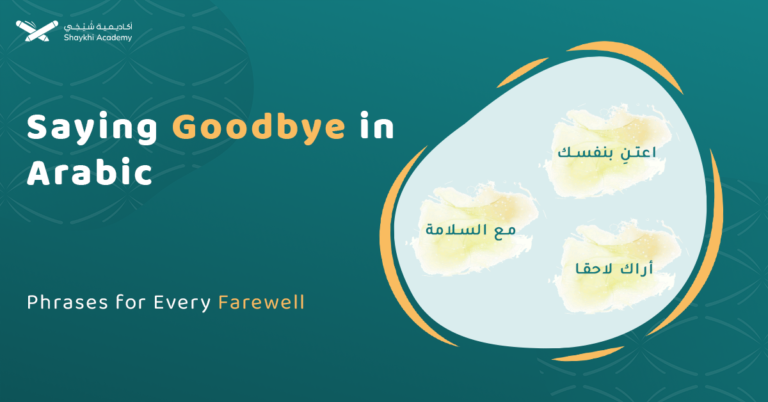When you think of any language you think of a new way to communicate to express your ideas or opinions, Arabic negation is a way to express your disagreement about something, or in other words, it’s how to say no in Arabic.
In this article, we will discuss Arabic negation and its structure, types, and forms simply so that you can apply them when using the Arabic language to express yourself.
Definition Of Arabic Negation (Nafy):
Arabic negation, or “نفي” (Nafy), is crucial for conveying denial and disagreement, employing particles like “لا” (La) and “ليس” (Laysa) based on tense and context.
Arabic negation النفي is using words, grammar, and structure to express your denial or disagreement about something. It’s highly needed in communication with other people in case you need to express a refusal.
Arabic negation has a lot of types and forms which depend on the structure and sometimes on the dialect itself. It is how you turn an affirmative situation into the opposite using different grammatical tools. Arabic negation is called “نفي” in Arabic which is pronounced “Nafy”.
Arabic Negation Examples:
| Type of Negation | Arabic Sentence | Pronunciation | Translation |
| Present Tense Negation | لا أكتب | La Aktub | I do not write. |
| Future Tense Negation | لن ألعب | Lan Al‘ab | I will not play. |
| Past Tense Negation | ما كتبت | Ma Katabt | I did not write. |
| Noun Negation with “ليس” (Laysa) | هو ليس جيدًا | Hwa Laysa Jayidan | He is not good. |
| Slang Negation with “مش” (Mesh) | مش هكتب | Mesh Hakteb | I will not write. |
Arabic Negation Rules:
Arabic negation rules are quite simple to follow. For verb negation, you just put the negation particle before the verb. Negation particles for verbs are
“ما”, “لم”, “لن”, and “لا” which we are going to discuss in more detail in this article.
For the negation of nouns and adjectives, you use the particle “ليس” before the noun or the adjective you want to negate, and it will also be discussed with more information.
Negative Sentence Forms:
Negative sentence structure in Arabic differs from any other language due to the unique structure of the Arabic language itself. Negative sentence structure has multiple forms that may vary according to the tense, such as:
- “لا” which is pronounced as “La”: for negation in the present.
- “ما” which is pronounced as “Ma”: for negation in the past.
- “لن” which is pronounced as “Lan”: for negation in the future.
- “لم” which is pronounced as “Lam”: for negation in the past.
Types of Negation in Arabic:
There are multiple types of negation in Arabic, that might differ according to the tense of the word itself whether it is a noun or a verb, like:
1. Negation in Arabic in the present for verbs with لا “La”:
Negation in the present for verbs with “لا”, pronounced as “La”, is used to deny an act that is happening in the present tense.
For example, “أِشرب”, which means “I drink”, is pronounced as “Ashrab”, in negation, it turns to “لا أِشرب” which means “I don’t drink” and is pronounced as “La ashrab”.
2. Negation in Arabic in the future for verbs with لن “Lan”:
Negation in the future for verbs with “لن”, pronounced as “Lan”, is used to deny an act that will happen in the future tense.
For example, “سألعب”, which means “I will play”, is pronounced as “sa’ala’ab”, in negation, it turns to “لن ألعب” which means “I won’t play” and is pronounced as “Lan ala’ab”.
3. Negation in Arabic in the past for verbs with لم “Lam” and ما “Ma”:
Negation in the past for verbs with “لم”, pronounced as “Lam”, and with “ما”, pronounced as “Ma”, is used to deny an act that happened in the past.
For example, “رسمت”, which means “I drew”, is pronounced as “Rasamt”, in negation, it turns to “ما رسمت” which is pronounced as “Ma rasamt” or “لم أرسم”, which is pronounced as “Lam Arsum”, Both means “I didn’t draw”.
4. Negation for slang Arabic dialect with مش “Mesh”:
Negation for slang Arabic dialect with “مش”, pronounced as “Mesh”, is used for the negation of verbs in present, past, and future tenses in different Arabic dialects, especially in Egyptian Arabic.
You can join our course Learning Egyptian Arabic from Shaykhi Academy for better understanding and further knowledge and information about it.
For example, in past tense “رسمت”, which means “I drew”, is pronounced as “Rasamt”, in negation, it turns to “مش رسمت” and is pronounced as “Mesh Rasamt”.
For example, in present tense “برسم”, which means “I draw”, is pronounced as “Barsem”, in negation, it turns to “مش برسم” and is pronounced as “Mesh Barsem”.
For example, in future tense “هرسم”, which means “I will draw”, is pronounced as “Harsem”, in negation, it turns to “مش هرسم” and is pronounced as “Mesh Harsem”.
5. Negation in Arabic for Nouns and adjectives with ليس “Laysa”:
Negation for nouns and adjectives with “ليس” is pronounced as “Laysa”, Laysa in Arabic is used to negate a word in a sentence which may be a noun or an adjective.
For example, “هو ماهر”, which means “He is clever”, is pronounced as “Hwa maher”, in negation, it turns to “هو ليس ماهرًا” and is pronounced as “Hwa laysa maheran”.
You can learn more about negation in Modern Standard Arabic and how to apply it by joining the Online Fusha Arabic Course with the best tutors in Shaykhi Academy to provide you with all the knowledge you need.
To learn more rules about Arabic Grammar and negation, join the Online Arabic Classes And Lessons course from Shaykhi Academy.
Book your free trial now!
Negating Verbs In Arabic:
Negating verbs in Arabic depends on the tense which guides you to use specific particles for each tense.
1. Negation of past-tense verbs:
For negation of past-tense verbs, we use particles like “لم” or “ما”, which are pronounced as “Lam” or “Ma”.
For example, “كتبت”, which means “I wrote”, is pronounced as “Katabt”, in negation, it turns to “ما كتبت” which is pronounced as “Ma Katabt” or “لم أكتب”, which is pronounced as “Lam Aktb”, Both means “I didn’t write”.
2. Negation in the present tense:
For negation in the present tense, we use the particle “لا”, which is pronounced as “La”.
For example, “أرسم”, which means “I draw”, is pronounced as “Arsum”, in negation, it turns to “لا أرسم”, which means “I don’t draw” and is pronounced as “La Arsum”.
3. Negation of verbs in the future tense:
For the negation of verbs in the future tense, we use the particle “لن”, which is pronounced as “Lan”
For example, “سأرسم”, which means “I will draw”, is pronounced as “Sa’arsum”, in negation, it turns to “لن أرسم”, which means “I won’t draw” and is pronounced as “Lan Arsum”.
4. Negation of imperative verbs:
Negation of imperative verbs in Arabic is somehow similar to imperative negation in English. We use the particle “لا”, which is pronounced as “La”, before the verb for both genders and in the case of singular or plural verbs.
For example, “ارسم” for singular and “ارسموا” for plural, which is pronounced as “Ersum” in case of it was for singular or “Ersumu” in case of it was for plural, means “Draw”.
In negation, It turns to “لا ترسم” for singular and “لا ترسموا” for plural which means “Don’t draw” and is pronounced as “La Tarsum” for singular, and “La Tarsumu” for plural.
Read more about Arabic Adverbs – أَحوَال (ʾaḥwal) And The Five Direct Objects (المفعولات الخمسة)
Negating Nouns And Adjectives In Arabic
Negatives without verbs are also part of the Arabic language. Nouns and adjectives can be negated using “ليس” which is pronounced as “Laysa”.
In different dialects, you can also use “مش” which is pronounced as “Mesh” for negation in slang language.
1. Laysa in Arabic:
Laysa in Arabic Language is a specific particle for negation of nouns and adjectives, it can be used in different forms according to the subject of the sentence and its gender.
A. If “Laysa” is for a singular male subject:
If Laysa is for a male subject, it’s used as “Laysa”. For example, “هو جيد”, which means “He is good”, is pronounced as “Hwa gaied”, in negation, it turns to “هو ليس جيدًا”, which means “He isn’t good” and is pronounced as “Hwa Laysa Gaiedan”.
B. If “Laysa” is for a singular female subject:
If Laysa is for a female subject, it’s used as “Laysat”. For example, “هي جيدة”, which means “She is good”, is pronounced as “Hya gaieda”, in negation, it turns to “هي ليست جيدة”, which means “She isn’t good” and is pronounced as “Hya Laysat gaieda”.
C. If “Laysa” is for talking about yourself/yourselves:
If “Laysa” is for talking about yourself, it’s used as “Lastu”. For example, “أنا بخير”, which means “I’m fine”, is pronounced as “Ana bekhayr”, in negation, it turns to “أنا لست بخير”, which means “I am not fine” and is pronounced as “Ana lastu bekhayr”.
If “Laysa” is for talking about yourselves, it’s used as “Lasna”. For example, “نحن بخير”, which means “We’re fine”, is pronounced as “Nahnu bekhayr”, in negation, it turns to “نحن لسنا بخير”, which means “We’re not fine” and is pronounced as “Nahnu lasna bekhayr”.
D. If “Laysa” is for talking to someone:
If “Laysa” is for talking to a male person, it’s used as “Lasta”. For example, “أنت بخير”, which means “You are fine”, is pronounced as “Anta bekhayr”, in negation, it turns to “أنت لست بخير”, which means “You’re not fine” and is pronounced as “Anta lasta bekhayr”.
If “Laysa” is for talking to a female person, it’s used as “Lasti”. For example, “أنتِ بخير”, which means “You’re fine”, is pronounced as “Anti bekhayr”, in negation, it turns to “أنتِ لستِ بخير”, which means “You’re not fine” and is pronounced as “Anti Lasti bekhayr”.
If Laysa is for talking to a group of people, it’s used as “Lastum”. For example, “أنتم بخير”, which means “You’re fine”, is pronounced as “Antum Bekhayr”, in negation, it turns to “أنتم لستم بخير”, which means “You’re not fine” and is pronounced as “Antum Lastum Bekhayr”.
2. Mesh in Arabic negation:
Mesh مش in Arabic negation may be used in Egyptian Arabic dialect as in many other dialects. It’s used for negation in slang language with a more simple and less structured form. You Just put “Mesh” before the word you want to negate.
For example, “هكتب”, which means “I will write”, is pronounced as “Hakteb”, in negation, it turns to “مش هكتب”, which means “I won’t write” and is pronounced as “Mesh hakteb” and so on.
Read more about Arabic Adjectives: A Comprehensive Guide to Usage, Agreement, And Types
Arabic Negation Exercises:
Now you need to exercise more and more to be perfect in negation. Here are some exercises for you to apply what you learned in this article:
- هو يكتب الدرس. Try to negate the underlined word in the present tense.
- نحن معلمون. Try to negate this sentence using one of the “Laysa” forms.
- هقرأ الكتاب. Try to negate this sentence using “Mesh”
- هي طويلة. Try to negate this sentence using one of the “Laysa” forms.
- أنا ذهبت إلى المنزل. Try to negate the underlined word in the past tense.
Book your free trial now!
Learn Online Arabic Classes And Lessons with Experienced tutors in Shaykhi Academy:
One of the best experiences you can gain is to Learn Online Arabic Classes And Lessons with Shaykhi Academy, Our friendly professional tutors use interesting techniques in teaching, and you can set your own suitable curriculum.
This course is affordable and helps you understand what you listen to in Arabic, It also helps you learn about Arabic Grammar Cases, common phrases, and conversations.
You can learn everything about modern standard Arabic (MSA) including negation in Arabic in this course, and it also allows you to be able to read and write Arabic and to interact in Middle East countries.
Why Shaykhi Academy?
- Expert Native Tutors: Learn from highly qualified native Arabic speakers.
- Flexible Scheduling: Tailor your classes to fit your busy life.
- Affordable Learning: Access top-quality education at a price that suits you.
- Global Access: Study from anywhere in the world.
Explore Our Arabic Courses:
- Noorani Qaida: Build a strong foundation in Quranic Arabic.
- Comprehensive Arabic Courses: Master the Arabic language, from beginner to advanced levels.
- Fusha Arabic Classes: Delve into Modern Standard Arabic, the key to understanding literature, media, and formal communication across the Arab world.
- Quranic Arabic Course: Enhance your connection with the Quran by learning the language in which it was revealed.
Start Your Arabic Journey Today! Whether you’re just starting or looking to deepen your knowledge, Shaykhi Academy is here to support your journey. Book your free trial now and begin your path to Arabic mastery!

In Conclusion
Arabic negation, known as “نفي” (Nafy), is essential for expressing disagreement or denial in the language. It utilizes specific grammatical structures and particles to convert affirmative statements into negative ones, depending on the tense of the verb or the nature of the noun.
Key negation particles include “لا” (La) for the present tense, “لن” (Lan) for the future, “ما” (Ma) and “لم” (Lam) for the past, and “ليس” (Laysa) for negating nouns and adjectives. Additionally, the slang particle “مش” (Mesh) is commonly used in dialects like Egyptian Arabic.
Arabic negation is an important grammar to learn so you can communicate and express your opinion about denying something, it uses multiple particles and forms according to the tenses and whether it is verb negation or noun negation.
If you need any help, Contact us for further information!


















































